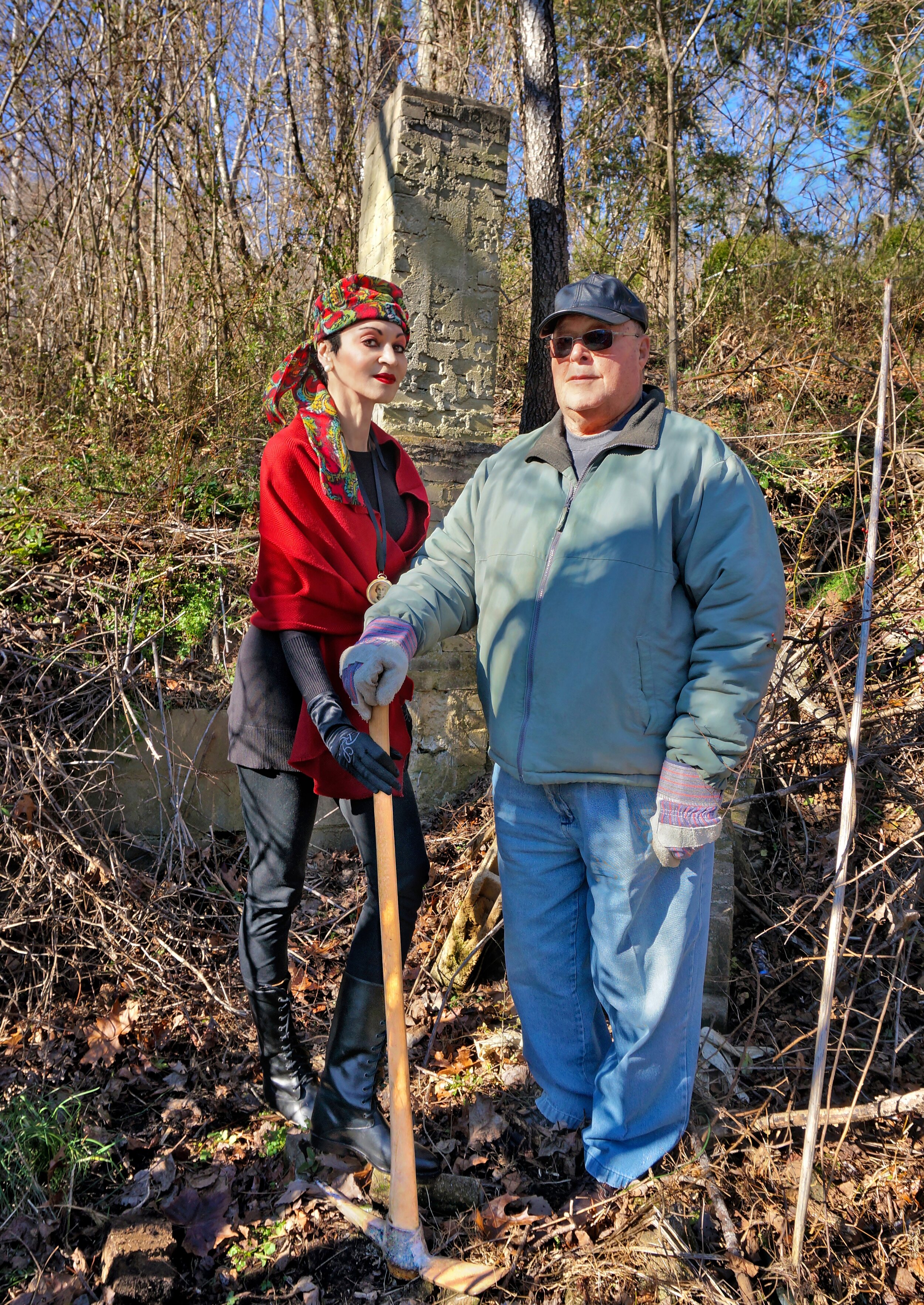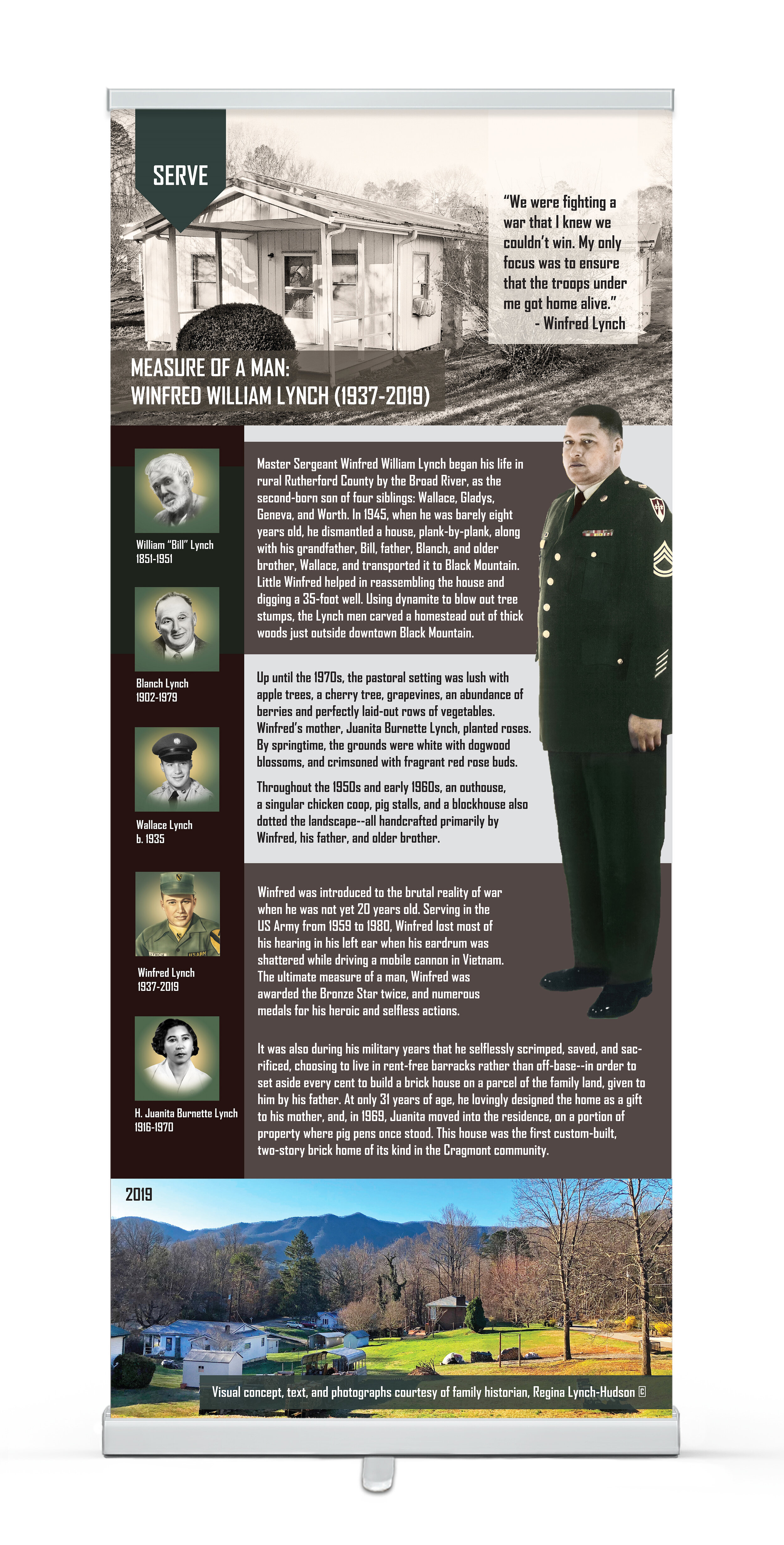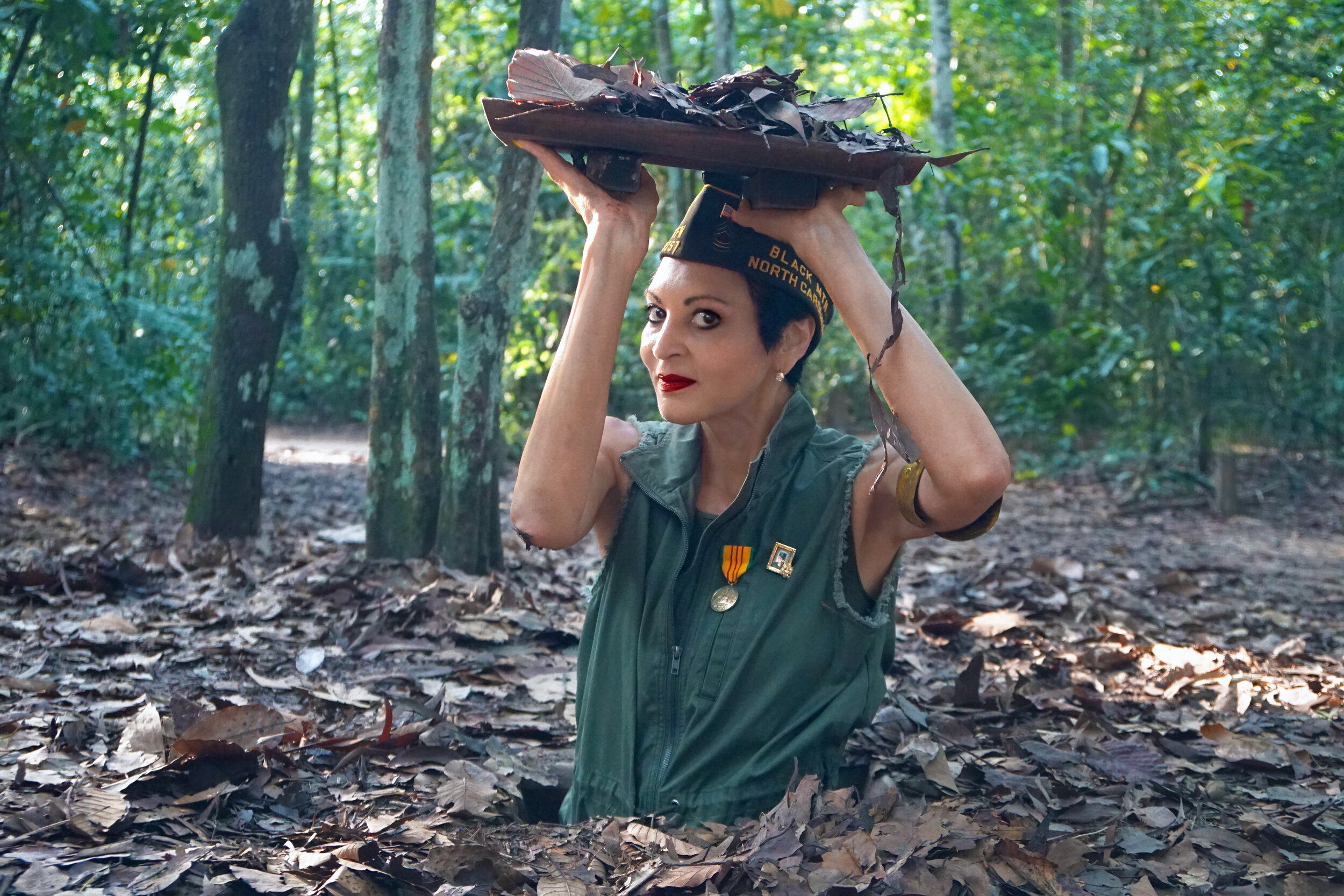Exhibiting Passion during Pain and Pandemic
Swannanoa Valley Museum installation tells stories of struggle and strength from the Cragmont community
Fred McCormick
The Valley Echo
August 3, 2020
Black Mountain native Regina Lynch-Hudson details the stories of her ancestors in a new exhibit unveiled by the Swannanoa Valley Museum & History Center in July. Photos courtesy of Regina Lynch-Hudson
The stories of her ancestors have been part of Regina Lynch-Hudson’s life for as long as she can remember. Carefully passed down through generations like a precious heirloom, they captivated the 62-year-old Black Mountain native as a child, and she grew to cherish those tales of strength and struggle. Fueled by a profound reverence for those who came before her, the semi-retired, Atlanta-based publicist and travel writer has spent decades passionately preserving and reviving her family’s rich history through curating and restoring hundreds of vintage photographs and documents.
Lynch-Hudson turned to her vast archive in June of 2019, as she mourned the sudden and unexpected loss of her uncle Winfred Lynch. Poring through a box of papers detailing the U.S. Army veteran’s service in the Vietnam War, Lynch-Hudson came to the realization that the time had come for her forebears to receive the recognition they had long deserved.
The concept of the online exhibit, “Strength Stems from Struggle,” produced by Lynch-Hudson and recently unveiled by the Swannanoa Valley Museum & History Center, began to take shape, but a global pandemic nearly prevented her from sharing the powerful stories of her ancestors.
In the months following Lynch’s death, his niece approached the museum with a proposal for an exhibit detailing the lives of four of her ancestors. Lynch-Hudson would develop the collateral to create individual panels—each over 7 feet tall—depicting written and visual history of the lives of John Myra Stepp, Mary Louisa Stepp Burnette Hayden, George Winslow Whittington and Lynch.
“When someone publicizes a family history, everyone is important, but you’ll always have what I call your torchbearers in a family,” Lynch-Hudson said of choosing the compelling lineup of personalities featured in the project. “You have those ancestors whose stories are a little more inspirational than most. These were people who endured significant challenges and came out on the other side with shining legacies.”
Collectively, the stories of the Stepp, Hayden, Whittington and Lynch, paint a vivid portrait of the experiences of people of color in the Swannanoa Valley during some of the most impactful time periods in the history of the country.
“During their respective lifetimes, our ancestors endured and survived slavery, the Civil War, Reconstruction, two world wars, the Spanish Flu, Jim Crow, the Great Depression, the Vietnam War and the Civil Rights Era,” Lynch-Hudson said.
Shortly before she took a month-long trip to Vietnam in honor of her late uncle in October of 2019, Lynch-Hudson received word from the museum that her proposal for the exhibit was approved. The tireless research proved a welcoming distraction from the pain of losing her father-like uncle.
She worked around the clock for six months to complete the project before the museum was scheduled to open for the season in April of 2020, but the exhibit was almost derailed by the onset of COVID-19.
Pandemic pushes exhibit in a new direction
“We were told that the museum would not be able to open in March, and at the time nobody really knew where everything was going with Covid,” Lynch-Hudson said. “We knew this wouldn’t blow over quickly, and I was so distressed that my family and the community would not be able to see these larger-than-life tributes. I knew something had to happen to make the exhibit available, digitally.”
While the first phase of the project offered respite from grief, producing a digital exhibit that would properly honor the subjects in the midst of a pandemic would require Lynch-Hudson to assemble a remote team.
“I’m not a videographer, but I have a history with directing,” she said. “I had to establish a budget, almost overnight, and then start piecing together who I could get to work with me to make this happen.”
Lynch-Hudson partnered with award-winning independent filmmaker Ayman Samman, who was born and raised in Cairo, Egypt and currently resides in Los Angeles. Elma Bandić, a resident of Sarajevo, Bosnia-Herzegovina, handled quality control and restoration for Regina’s hand-picked imagery. Atlanta-based sound engineer Marc Freeman brought more than 40 years of experience as a composer, which includes work with Grammy Award-winning artist Peabo Bryson, to the project.
The soulful baritone of Memphis-based Army veteran David B. Kelley would give a voice to Stepp and Lynch in their respective videos. Singer and songwriter Dorie Pride, a member of the National Academy of Recording Arts & Sciences and Grammy Award voter, provided the voice for Hayden. Carey Conley, a professional voiceover actor out of Atlanta, chronicled Whittington's story.
“The coming together of the award-winning video team was nothing short of miraculous,” said Lynch-Hudson, who has collaborated with creative teams worldwide and conceptualized and directed videos for clients throughout her career.
The video series “Strength Stems from Struggle” shows what can be achieved digitally with global partners without ever being in the same room, she said. It also shows the power of the universe to unite compatible talent for inspirational projects, she added, even during the worst of times.
The final product, a series of four short biographical videos detailing the challenges and triumphs of the four Western North Carolina natives, debuted on the Swannanoa Valley Museum & History Center’s website in July.
A panel documenting the life of John Myra Stepp, who was born into slavery in Black Mountain and later became a respected business man in the community, is one of four featured in the “Strength Stems from Struggle” exhibit in the Swannanoa Valley Museum & History Center.
The stories of Lynch-Hudson’s ancestors are deeply rooted in the Swannanoa Valley, specifically in the Cragmont community on the west side of Black Mountain where Stepp, Hayden, Whittington and Lynch rest today.
Born into slavery in Black Mountain in 1850, Stepp was the offspring of slave owner Joseph Stepp and an enslaved woman named Myra. John Myra, who was known as “Myra’s John” until changing his name after being emancipated, would spend the first 15 years of his life forced to tend to the needs of the summer tourists that frequented the area.
As a free man, John Myra’s intelligence and natural entrepreneurial spirit would propel him to the status of respected businessman and proficient farmer in the community. He would eventually earn enough money as a veterinarian to purchase property in Black Mountain. He settled with his family on a farm in Montreat and owned 10 houses throughout the community. Known for his generosity, he provided shelter to tenants who were unable to pay rent.
Slavery prevented John Myra from receiving a formal education as a child, but he was keenly aware of the need for a school that would serve Black students. He personally funded the Flat Creek Road School, the first educational institution for African-American children in Black Mountain. Prior to his death in 1955, John Myra was named an honorary member of the local school committee.
“His story shows that no matter what the obstacle, you can still leave a profound legacy,” Lynch-Hudson said. “His situation could have turned out differently, but his mindset didn’t allow him to be held back.”
Stepp’s legacy continues to be celebrated by his descendants to this day, as the family passes his story down to the next generation, according to Lynch-Hudson.
“John Myra was perhaps the most iconic and accomplished African-American to have come from slavery in the Valley,” she said. “It was very rare for an African-American man to receive the press and recognition that he did back in his day.”
Mary Louisa Stepp Burnette Hayden delivered hundreds of babies in the Swannanoa Valley in the 19th and 20th centuries. Her story is among those featured in the “Strength Stems from Struggle” exhibit at the Swannanoa Valley Museum & History Center.
Midwifery was a crucial skill in the late 19th and early 20th centuries in the mountains, and it was one that was typically passed on to daughters from their mothers. Hayden was born on the Stepp plantation in 1858 to an enslaved midwife named Hanah. Emancipated at the age of 5, Hayden began assisting her mother at a young age.
While Hayden received no formal education in medicine, she would deliver hundreds of babies of all races during her lengthy career as a midwife in the Swannanoa Valley. Until her death in 1956, Hayden employed her skills as an herbalist and natural healer, and her knowledge of native vegetation to provide needed health services for local families.
Hayden would live out her final years in a cottage on Byrd Road that was built by her son. All that remains of the structure is a chimney, which Lynch-Hudson returned to “for the umpteenth time” a couple of years ago.
“I wanted to go back to that chimney when I came to Black Mountain for a visit,” she recalled. “I had a hunch that told me to revisit the property where my great-great-grandmother once lived and I went with my uncle. We talked for over an hour with the woman who now lives on the property because she’s lived there since childhood, when her family acquired the land. My uncle questioned her about the absence of a Willow tree that was once a focal point of the property.”
Regina Lynch-Hudson and her uncle Winfred Lynch visit the chimney that was once part of the Black Mountain cabin that their ancestor, Mary Louisa Stepp Burnette Hayden once lived in. Hayden is one of four historical figures whose lives are chronicled in the “Strength Stems from Struggle” exhibit at the Swannanoa Valley Museum & History Center.
Lynch and his niece learned that the tree was destroyed by a lightning strike decades ago, but the woman had retrieved a remnant from the tree before it was removed.
“The way that the piece of the tree was preserved, it resembles a magnificent sculpture that you would find in a museum; it was absolutely beautiful,” Lynch-Hudson said. “I purchased it from her. I feel like I was led to her because I now have a treasure from a tree that was originally planted by my great-grandfather.”
Voice actress Dorie Pride also felt led to Mary Lousia Stepp Burnette Hayden, in what she describes as an “an immediate connection.”
“When I first laid eyes on images of Mary Lousia Stepp Burnette Hayden, and opened my mouth to narrate her story, it was if she had been waiting for me,” Pride said. “It was as if her energy had entangled into mine and I became her vessel to speak. It was quite a spiritual encounter.”
Though Pride has composed songs for luminaries such as Janet Jackson and Johnny Mathis, she says that it was the humble mountain medicine woman who touched her soul “in a visceral way.”
George Winslow Whittington, reportedly the first African-American brakeman for the N.C. Southern Railway, is one of four historical figures from Black Mountain to be featured in the “Strength Stems from Struggle” exhibit at the Swannanoa Valley Museum & History Center.
Whittington was born in the Pleasant Gardens community in McDowell County in 1900, though he would spend 42 years of his life as a respected resident of Black Mountain.
Introduced to the railroad by his father Benjamin at a young age, Whittington would later reportedly become the first African-American brakeman for the N.C. Southern Railway. His position, which required him to walk on top of the box cars to manually set the brakes as the engine steamed through tunnels connecting Old Fort to Ridgecrest, was among the most perilous jobs in the industry.
He was compensated well for his work, and the train passes he received as a railroad employee allowed him to travel to big cities throughout the region with his wife (Minnie Stepp Whittington) and their nine children. While riding the rails provided steady employment to support his family, his hard work and dedication helped Whittington and his wife produce seven college graduates from the Cragmont community.
“Voicing George Winslow Whittington’s script was not only an honor and an inspiration, but was educational,” said Carey Coney, who has orated television and radio commercials for clients such as Chrysler, Comcast, and KFC. “As a narrator of color, it's always great when a job turns into a lesson on great people of color.”
Winfred William Lynch began his life of service on the banks of the Broad River before moving to Black Mountain as a child. The U.S. Army veteran’s story is one of four featured in the “Strength Stems from Struggle” exhibit at the Swannanoa Valley Museum & History Center.
Long before he was awarded two Bronze Stars for his heroic actions during the Vietnam War, Lynch’s life of service began on the banks of the Broad River in Rutherford County. Barely 8 years old, working alongside his grandfather Bill, his father Blanch and his brother Wallace, he painstakingly dismantled the family home and reassembled it, plank by plank, on a wooded piece of land in Black Mountain. As a young man, Winfred was introduced to the harsh realities of war, where he would eventually lose hearing in his left ear after suffering a shattered eardrum in battle.
Winfred, however, remained undeterred in his service to his country and his family. He would rise to the rank of Master Sergeant before retiring from the military in 1980, but the sacrifices he made along the way created a better life for those he loved.
By the age of 31, Winfred saved enough money from his earnings in the military to design and build a two-story brick house for his mother, Juanita Burnette Lynch, on a parcel of land given to him by his father. It was the first of its kind in the Cragmont community.
While his military career provided him with a means to take care of his family, many of the documents uncovered by Lynch-Hudson during her research for the exhibit painted a picture of the many challenges he endured.
“Other papers documented his lifelong struggle with the Veterans Administration to have his medical disability increased as his hearing disability grew progressively worse,” she said. “He also suffered adverse physical effects due to exposure to Agent Orange – a deadly herbicide and defoliant chemical, developed by Dow Chemical Company, which was sprayed on our own troops in an effort to defoliate the vegetation around bases in Vietnam so the U.S. Army could see the enemy approaching.”
Regina Lynch-Hudson, wearing the medals and cap of her late uncle Winfred Lynch, retraces the Vietnam War veteran’s footsteps through the tunnels in Saigon. Lynch is one of four of Lynch-Hudson’s ancestors featured in the exhibit, “Strength Stems from Struggle,” which is now display at the Swannanoa Valley Museum & History Center’s website.
Though they never met, David B. Kelley felt a kinship with Winfred as he learned of his story.
“Narrating Winfred Lynch’s biography had an emotional impact on me, because I continue to live what Winfred Lynch started,” he said. “Winfred and I are only two veterans, and imagine that there are thousands, if not millions, who never get to receive fair compensation.”
Important stories that need to be told
The role that Stepp, Hayden, Whittington and Lynch played in the history of the Swannanoa Valley is significant, according to museum director LeAnne Johnson.
“These four people helped make the Swannanoa Valley what it is today,” she said. “They contributed to the culture of this community, and it’s important that their stories are represented.”
The four panels will be added to the Our Pathways exhibit on the second floor, but the museum is not permitted to open to the public until Phase 3 of the state’s Safer at Home order. The videos, however, have been compiled into a unique virtual exhibit on the museum’s website.
“Regina did an awesome job on this project,” Johnson said. “These videos are not something that, as a small museum, we would have been able to afford. The fact that she poured her resources, time and spirit into these videos really shows how much she cares about her family, their legacies and their impact on this community.”
Inspired by the pain stemming from the sudden loss of a loved one, and adapted in the face of a global pandemic, “Strength Stems from Struggle” shines a bright light on the lives of key historical figures in the Swannanoa Valley while highlighting their continued relevance.
“Out of all of the assignments, jobs and experiences that I’ve had over the course of my 30-year career, this project has brought me the most meaningful joy,” Lynch-Hudson said. “These are important, inspirational stories that need to be told, especially today. We live in a society that primarily focuses on celebrities and the frivolous accolades of people with big titles, but I believe that you learn more about true strength when you unveil the stories of people who really are the foundational fabric of this country.”







